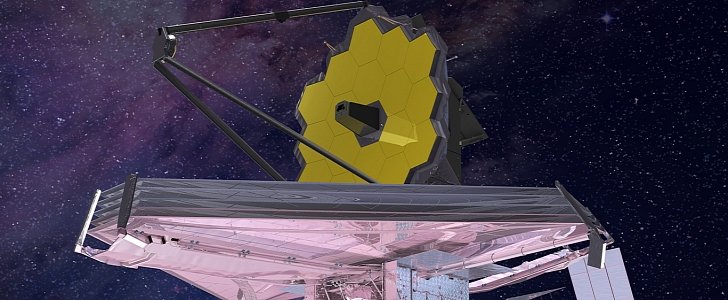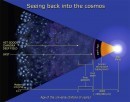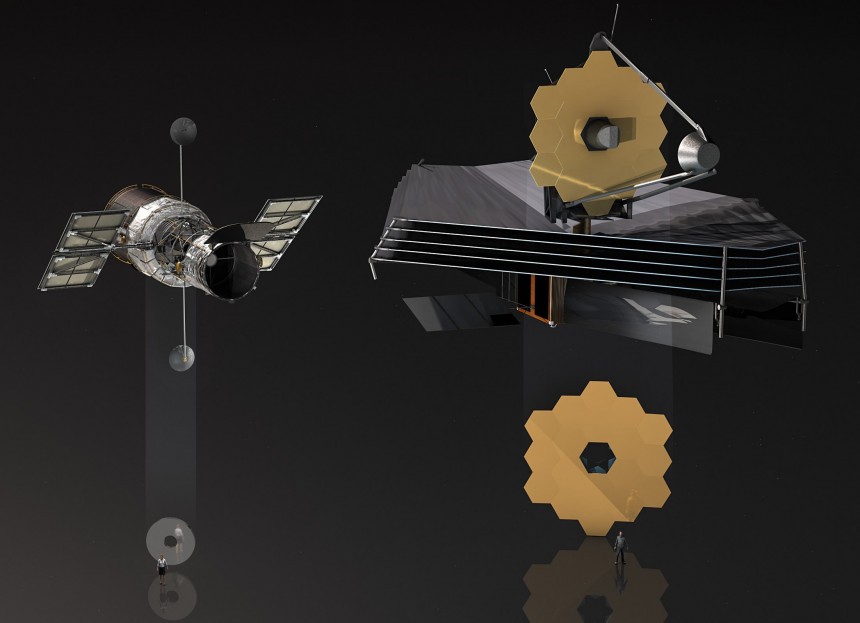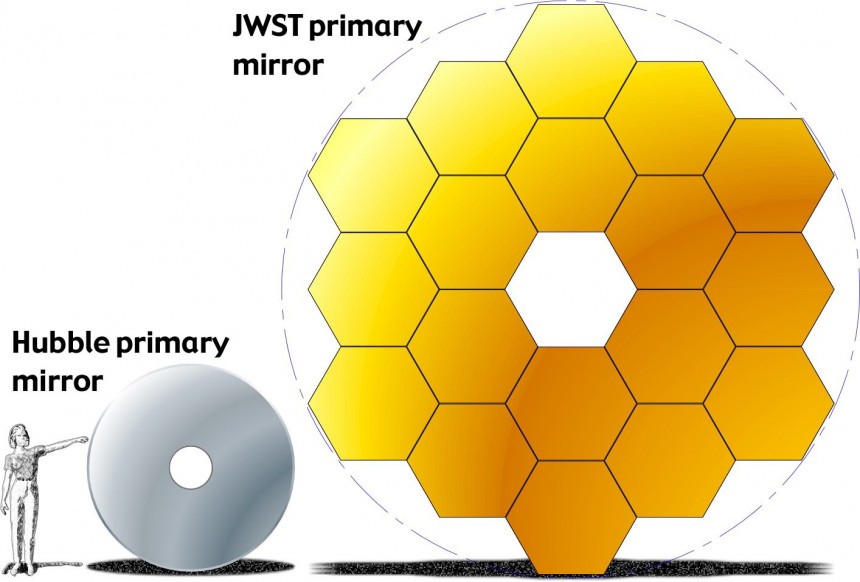Peering into other worlds that are light-years away has fascinated us for centuries. Technology has granted us closer and better views of distant parts of the universe, and the picture will keep improving.
The best way to observe distant galaxies, stars and nebulae is to have a telescope in the void of space, one whose view is not blurred by our Earth’s atmosphere. That’s why space telescopes like the well known Hubble Space Telescope (HST) have been providing truly spectacular and eye-opening images of places that would require tens or hundreds of thousands of years to travel to with current propulsion tech.
Hubble has shown us spots so far away that when we observe them, we’re actually seeing them as they were when the photons were emitted. In other words, we’re looking so far into the distance, that we’re actually looking into the past, since even light needs time to travel. And we’ve been able to observe all the way to what is perceived to be the edge of the universe, thus we were able to observe what the young universe was like eons ago.
That is a mind-boggling and quite fascinating prospect, if you stop and think about it, from both a scientific and philosophical standpoint. The problem is, even the mighty HST (launched in April 1990) is showing its limitations, and our images of the furthest celestial bodies and places are corrupted and blurry.
Hubble was and still is a remarkable feat of engineering, one whose contribution to helping us understand the universe cannot and should not be underestimated. But even after four manned missions for the purpose of maintaining and upgrading the telescope, the last of which took place in 2008, it was deemed necessary that it be replaced by an altogether superior hardware.
The James Webb Space Telescope (JWST) was envisioned as a replacement for Hubble and work on it actually began in 1996. Back then, its initial planned launch date was sometime in 2007, but various setbacks (including a major redesign in 2005) have pushed its planned launch date to the end of March, 2021.
The previous launch date for JWST was in June of 2018, but it was pushed back again because the telescope’s sun shield actually tore during a practice deployment procedure. We really hope it won’t be delayed again, because we’re expecting it to show us remarkable things, some which we’ve never seen before, or a much clearer and better picture of things we’ve only just barely glanced at with Hubble.
Why are we so excited about James Webb? Well, even if its total mass is roughly half that of Hubble, JWST’s primary mirror is 6.5 meters/21.3 feet in diameter, or nearly six times larger than Hubble’s. It's also the most complex telescope humans have ever sent into space. And its mirror is not just any mirror, as it’s actually a gold-coated beryllium reflector - by using this type of surface, scientists say we’ll be able to observe more of the light spectrum, from near-infrared, to very cold objects like planets and debris fields.
It must be pointed out, though, that JWST is not a direct replacement for HST, since it has been designed to primarily observe in the infrared part of the spectrum where HST’s instruments can’t quite reach. This will essentially allow JWST to peer through dust and debris better than HST and show us what’s behind in much greater detail.
It’s also going to be placed much further away from home than Hubble which orbits in low Earth orbit, at an altitude of around 540 km (338 miles). JWST will not orbit the Earth, but it will go around the Sun instead, at a distance of around 1.5-million kilometers or 1-million miles away from home, in a spot called L2. That's a shortened form for the Second Lagrangian point, where the telescope will orbit the sun pretty much as the Earth does.
In purpose, it is closer to the Herschel Space Observatory, active between 2009 and 2013, which is currently the largest infrared telescope ever launched. It has a 3.5-meter/11.5-foot mirror and its instruments are sensitive all the way into the far infrared. Another point where Herschel is similar to James Webb is the place of orbit - the former was also placed near L2.
But whereas Herschel looked at very active places where stars are being formed, JWST has been designed to be able to spot the first galaxies formed in the early universe. These are called “baby galaxies,” whereas the slightly older ones that HST was able to observe are known as “toddler galaxies.”
JWST will have four instruments on board with different wavelength coverages, but they will all be concentrated in the near-infrared field. In order to observe baby galaxies, extreme near-infrared sensitivity is required and that’s exactly what the new telescope will provide.
Basically, it will grant us the best look yet at what the early universe was like. It will be an unprecedented feat that is not only of importance to the scientists actively studying this field, but also to those who are just fascinated by both astronomy and cosmology.
Once JWST launches and becomes active, it will hopefully answer many of our early universe-related questions, while at the same time make us ask additional questions that we have not even have thought of right now. On top of this, the telescope will also be aimed at the center of our galaxy and we expect to get the best picture yet as to what exactly lies at the core of the Milky Way. It will also be able to show us our solar system's outer planets in never before seen detail too.
Hubble has shown us spots so far away that when we observe them, we’re actually seeing them as they were when the photons were emitted. In other words, we’re looking so far into the distance, that we’re actually looking into the past, since even light needs time to travel. And we’ve been able to observe all the way to what is perceived to be the edge of the universe, thus we were able to observe what the young universe was like eons ago.
That is a mind-boggling and quite fascinating prospect, if you stop and think about it, from both a scientific and philosophical standpoint. The problem is, even the mighty HST (launched in April 1990) is showing its limitations, and our images of the furthest celestial bodies and places are corrupted and blurry.
The James Webb Space Telescope (JWST) was envisioned as a replacement for Hubble and work on it actually began in 1996. Back then, its initial planned launch date was sometime in 2007, but various setbacks (including a major redesign in 2005) have pushed its planned launch date to the end of March, 2021.
The previous launch date for JWST was in June of 2018, but it was pushed back again because the telescope’s sun shield actually tore during a practice deployment procedure. We really hope it won’t be delayed again, because we’re expecting it to show us remarkable things, some which we’ve never seen before, or a much clearer and better picture of things we’ve only just barely glanced at with Hubble.
Why are we so excited about James Webb? Well, even if its total mass is roughly half that of Hubble, JWST’s primary mirror is 6.5 meters/21.3 feet in diameter, or nearly six times larger than Hubble’s. It's also the most complex telescope humans have ever sent into space. And its mirror is not just any mirror, as it’s actually a gold-coated beryllium reflector - by using this type of surface, scientists say we’ll be able to observe more of the light spectrum, from near-infrared, to very cold objects like planets and debris fields.
It’s also going to be placed much further away from home than Hubble which orbits in low Earth orbit, at an altitude of around 540 km (338 miles). JWST will not orbit the Earth, but it will go around the Sun instead, at a distance of around 1.5-million kilometers or 1-million miles away from home, in a spot called L2. That's a shortened form for the Second Lagrangian point, where the telescope will orbit the sun pretty much as the Earth does.
In purpose, it is closer to the Herschel Space Observatory, active between 2009 and 2013, which is currently the largest infrared telescope ever launched. It has a 3.5-meter/11.5-foot mirror and its instruments are sensitive all the way into the far infrared. Another point where Herschel is similar to James Webb is the place of orbit - the former was also placed near L2.
But whereas Herschel looked at very active places where stars are being formed, JWST has been designed to be able to spot the first galaxies formed in the early universe. These are called “baby galaxies,” whereas the slightly older ones that HST was able to observe are known as “toddler galaxies.”
Basically, it will grant us the best look yet at what the early universe was like. It will be an unprecedented feat that is not only of importance to the scientists actively studying this field, but also to those who are just fascinated by both astronomy and cosmology.
Once JWST launches and becomes active, it will hopefully answer many of our early universe-related questions, while at the same time make us ask additional questions that we have not even have thought of right now. On top of this, the telescope will also be aimed at the center of our galaxy and we expect to get the best picture yet as to what exactly lies at the core of the Milky Way. It will also be able to show us our solar system's outer planets in never before seen detail too.















